The best places to find fossils are arid areas with rocky outcrops. There are three basic kinds of rocks: igneous, formed from melting rock; sedimentary, eroded by wind or water and later redeposited, and metamorphic, changed by extreme heat or pressure. Almost all fossils are found in sedimentary rocks. This is because the intense heat and pressure that create igneous and metamorphic rocks often destroy fossils. Scientists use a method called absolute dating to date rocks. Absolute dating uses the radioactive decay of an isotope mineral in an igneous and in a metamorphic rock to determine the age of the rock layer below and/or above a sedimentary rock layer. When a radioactive isotope (parent material) decays, it forms a new isotope, a daughter product. The half-life of a radioactive element is the time it takes for half of its atoms to decay into the daughter product. When two half-lives have passed, one-fourth of the original isotope's atoms remain and three-fourths have turned into the daughter product. By measuring the amounts of parent and daughter materials in a rock and by knowing the half-life of the parent material, a geologist can calculate the absolute age of the rock. This method is called radiometric dating.
Procedure:
1. A dinosaur fossil is shown. Examine the fossil, paying particular attention to its size in relation to the metric ruler. Record the location where the fossil was found and its length in the Table.
2. Select the rock samples gathered from the rock layers above and below the fossil site and drag and drop them, one at a time, to the mass spectrometer for radiometric analysis. Click the start button to display the results on the monitor for each rock. Use the graphs to determine the age of each rock layer. Be sure to look at the title of the graph, which provides the half-life of the parent material. Record this information in the Table.
3. Use The Geologic Time Scale reference and the information about the rock layers to determine in what geologic period the fossilized dinosaur lived. Record that information in the Table.
4. Use the information you have gathered and analyzed, along with the information in the Dinosaur Guide, to identify the dinosaur fossil. Record the identity of the fossil in the Table.
5. Select the Reset button to reset the lab exploration to investigate a different dinosaur fossil.
6. Repeat steps 1-5 for the remaining dinosaur fossils.
7. When all the data are analyzed and recorded in the data table, answer the Journal Questions.


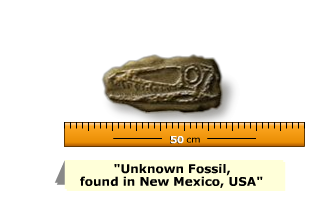



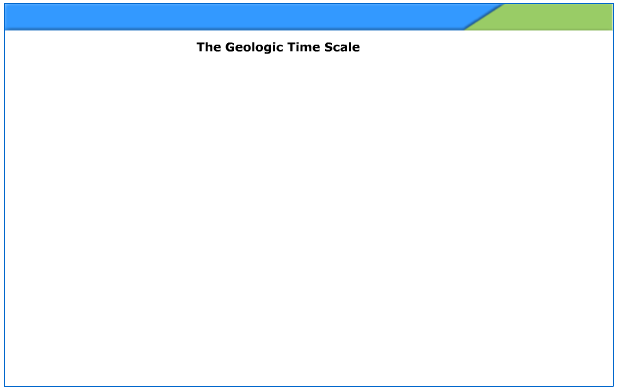






title
title
num
num




Coelophysis was one of the earliest-
known dinosaurs. It lived during the late Triassic period, about 210 million years ago. It lived in a seasonally dry, desert-like environment.

Coelophysis is believed to have been a very fast, bipedal runner because of its slight, long-legged build and light, hollow bones. Speeds can be estimated using leg length measurements, estimated body mass, and fossilized tracks. Coelophysis most likely reproduced by laying eggs.
Diplodocus had a horse-like head that was less than 60 centimeters long. The nostrils were at the top of the head. Diplodocus was an herbivore with peg-like, blunt teeth in front of the jaws useful for stripping leaves from plants. It may have swallowed stones that remained in its stomach to help digest the leaves.


Stegosaurus lived during the late Jurassic period, about 156-140 million years ago. Stegosaurus was up to about nine meters long, about three meters tall, and weighed about 3100 kg. Its small brain weighed less than 100 grams, making its intelligence, as measured by its brain to body weight, relatively low among dinosaurs.
and an armor-like skin on the neck, and perhaps on some other parts of its body.
The dinosaur's rear legs were much longer than its front legs. The front feet had five toes with hooves; the rear feet had three toes with hooves. Most likely it walked on four legs carrying its pointed and narrow head close to the ground. Stegosaurus was an herbivore with a toothless beak and small cheek teeth. It is still debated whether it may have been able to rear up on its hind legs to reach vegetation.
fingers. Although it had feathers and could fly, it probably did not fly very well.
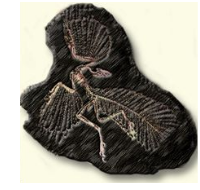
Archaeopteryx lived about 150 million years ago during the Jurassic period. It had a wingspan of about 50 cm and was about 30 cm long from beak to tail.
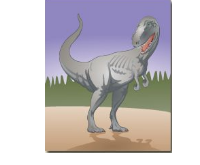
Tyrannosaurus lived during the late Cretaceous period, about 85 million to 65 million years ago. It lived in a semi-tropical environment, probably in open forests. Tyrannosaurus was a predator, and perhaps also a scavenger, that walked on two powerful legs. Its prey was herbivorous dinosaurs.
T.rex had relatively small arms, each with two fingers. Each foot had three large toes, with claws. T.rex had a slim, stiff, pointed tail that provided balance and allowed quick turns while running. T.rex's body was solidly built but its bones were hollow. Its brain dedicated a relatively large area to the processing of visual and olfactory (odor) information, an important ability for a predator.

Coelophysis was a carnivore and may also have been a scavenger. It was a small dinosaur that walked on two legs and was about three meters long. It had three clawed fingers on its hands, and a long neck. It had a pointed head with dozens of small, serrated teeth.
Fossil bonebeds of hundreds of Coelophysis have been found suggesting that the animals probably lived and hunted in packs.

Diplodocus was a long-necked, giant dinosaur about 27 m long with an 8 m long neck, a 14 m long whip-like tail, and a row of spines running down its back. Diplodocus lived in the late Jurassic period, from 155 to 145 million years ago. The word "Diplodocus" is taken from the Greek meaning "double-beamed," and this dinosaur was so named because of its extra bony protrusions both forward and backward underneath the vertebrae.
Diplodocus had thin, fragile ribs that helped support and protect the internal organs. These ribs were attached to the skin in the belly area. Diplodocus' intelligence, as measured by its relative brain to body weight, was among the lowest of the dinosaurs.
Fossilized tracks and other evidence indicate that Diplodocus walked slowly on four elephant-like legs with five-toed feet, with a thumb claw on each foot. It is believed that it could hold its neck only about 5.4 m off the ground. These dinosaurs may have traveled in herds. They probably laid eggs and it is likely that they did not take care of their eggs.

Stegosaurus had triangular plates embedded in its back. They were made of bone and were probably filled with blood vessels. The function of these plates is not known. They may have been used to regulate the dinosaur's temperature. The largest of these plates was about 75 cm in diameter. For protection from predators Stegosaurus had spikes at the end of its flexible tail
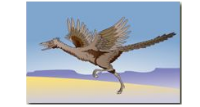
Archaeopteryx is an animal with bird-like and dinosaur-like features. Paleontologists think that Archaeopteryx represents a dead-end in evolution and that another group of dinosaurs led to the modern birds. Some of Archaeopteryx's dinosaur features included: teeth, lack of a horny bill, three claws on each wing, a flat breastbone, belly ribs, and a long, bony tail. Like today's birds, it had feathers, hollow bones, a wishbones and reduced
It probably weighed between 300 to 500 grams.
The first fossil found was a feather. A total of eight Archaeopteryx fossil specimens have been found near Solnhofen in Germany. This area was a lagoon during the Jurassic Period with hardly any oxygen in the bottom water layer. This situation helped to preserve dead organisms, and increased the chance of fossil formation.
Tyrannosaurus was up to 12 m long, between 4 and 6 m tall, and probably weighed between 5000 to 8000 kg. It had jaws with large, pointed, serrated teeth. Teeth of T.rex have been found that were up to 30 cm long. Adults had a variety of sizes of teeth in their jaws; as teeth were broken new ones grew in to replace them. When T.rex closed its mouth, the upper parts of the lower jaw's teeth fit inside the upper teeth.
